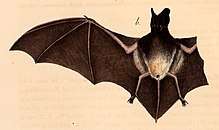Asian barbastelle
| Asian barbastelle | |
|---|---|
 | |
| Scientific classification | |
| Kingdom: | Animalia |
| Phylum: | Chordata |
| Class: | Mammalia |
| Order: | Chiroptera |
| Family: | Vespertilionidae |
| Genus: | Barbastella |
| Species: | B. leucomelas |
| Binomial name | |
| Barbastella leucomelas Cretzschmar, 1826 | |
| Synonyms | |
| |
The Levant barbastelle (Barbastella leucomelas) is a species of vesper bat. Its habitat is temperate forests and caves. It is threatened by habitat loss. It can be found in Egypt (Sinai), Israel, Saudi Arabia, and Eritrea.
Taxonomy and etymology
It was described as a new species in 1826 by German scientist Philipp Jakob Cretzschmar. Cretzschmar initially placed it in the genus Vespertilio, with the binomial Vespertilio leucomelas.[2] Its species name "leucomelas" is from Ancient Greek "leukomélās" meaning "black and white."
Description
Its forearm is 38–39 mm (1.5–1.5 in) long and its tail is 19–20 mm (0.75–0.79 in) long. Its ears are large and forward-facing. The tragi are large as well and very hairy. Its fur is blackish on its back but more brown on its ventral side. Its thumb is quite small, at 4 mm (0.16 in) long including the claw.[3]
Biology and ecology
During the day, it roosts in sheltered places such as old buildings.[3]
Range and habitat
It is widely distributed throughout Asia and its range extends into a few African and European countries as well. It has been documented in the following countries: Afghanistan, Armenia, Azerbaijan, Bhutan, China, Egypt, Eritrea, Georgia, India, Iran, Israel, Japan, Kyrgyzstan, Nepal, Pakistan, Russia, Saudi Arabia, Taiwan, Tajikistan, Turkmenistan, and Uzbekistan. It has been documented up to 2,500 m (8,200 ft) above sea level.[1]
References
- 1 2 Monadjem, A.; Tsytsulina, K.; Hutson, A.M.; Benda, P.; Aulagnier, S.; Sharifi, M. (2017). "Barbastella leucomelas". The IUCN Red List of Threatened Species. 2017: e.T85181182A22029016.
- ↑ Cretzschmar, P. J.; Rüppell, E. (1826). "Atlas zu der reise im nördlichen Afrika". Frankfurt am Main :Gedruckt und in Commission bei Heinr. Ludw. Brönner,1826-1828: 73.
- 1 2 Hoath, R. (2009). A field guide to the mammals of Egypt. American Univ in Cairo Press. pp. 64–65. ISBN 9774162544.
